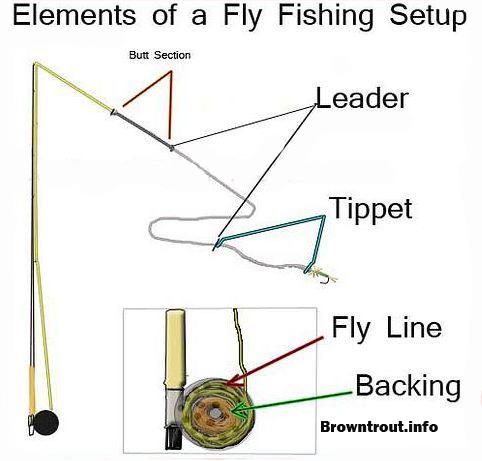This post was last updated on August 8th, 2021 at 08:12 am
What’s in a Fly Fishing Line Setup?
 The fly fishing line setup has a few basic parts. In order to properly set up your reel, you will need to know the order to piece it all together. This can seem a little confusing to a new fly fisherman. I will try to lay it out as easily as possible to understand.
The fly fishing line setup has a few basic parts. In order to properly set up your reel, you will need to know the order to piece it all together. This can seem a little confusing to a new fly fisherman. I will try to lay it out as easily as possible to understand.
The Basic Parts of a Fly Line Setup
- Backing
- Fly line
- Butt section
- Leader
- Tippet
Fly Line Backing
The first parts of a fly line is the backing. Its the first layer of line that you will attach to your reel. You will put this on the reel before anything else. Backing is made from dacron usually. It is a high strength material that is used to fill up the inner most part of the reel. If you don’t use backing you will be sacrificing a few very key elements that you need.
The two major functions of backing are:
- To take up the excess space in the reel to give you a better ratio reeling up the line. This is very important. Imaging winding line around a spool of thread. It would take you a very long time to wind up even a few feet of line. Now imagine winding your line around something closer to the size of a pop can. Winding it around a pop can will surely go much faster no? Its the same concept here with the backing. You need that extra bulk at the base of your reel to reel in your line faster.
- Backing also will ensure that if you hook a large trout it won’t run out of line and leave you standing there watching 70$ worth of fly line swimming away. Its sort of an insurance policy. It is very common to have a big fish pull all of your line out of the reel. Either the fish will break the knot, or break your line. Either way its no fish for you without backing.
Fly Fishing Line
The fly fishing line is the bulky floating line that is what you are casting. I have written a long article about the different types of fly line for trout. The fly fishing line will be attached to your backing by a knot known as an albright knot, or a nail knot. I won’t go into the functions of fly line because that is covered in detail in the link a couple sentences back.
Butt Section
The butt section is simply a large diameter piece of fly line that attaches to your fly fishing line. It is typically only a foot or two in length. The main purpose of butt sections is to allow you to tie the complex and (for some people) time consuming nail knot only one time. Otherwise if you tied your leader directly to your fly line each time, you would gradually be trimming away the end of your expensive fly line every time you changed your leader.
Leader
The leader is a tapered piece of mono-filament that at the heaviest end is typically around 40# test. The lightest end can be around 4.lbs usually. The new modern day leaders are tapered by a machine and are totally “knotless”. Back in the day (before my time) all leaders were hand tied piece by piece using a series of blood knots. The purpose the the tapering on the leader is to allow your line to roll out nicely. If you use one solid piece of fishing line, your fly could end up underneath a big pile of fishing line once it lands on the water. I won’t go too much into the physics of it here.
Tippet
The last part of the fly fishing line setup is the tippet. The tippet is the last piece of line you would use before the fly. Often times you won’t even need to use a tippet. But its a good idea to use tippet slightly lighter tensile strength than your leader. This will cause the tippet to break off under heavy load, instead of breaking off a portion of your tapered leader. Tippet is available in many different sizes and fits together nicely in one big roll. (see pic)
The Fly Fishing Line Setup Doesn’t Need to be Complicated
That is the basics of fly fishing line. Check out our complete guide on setting up setting up a fly reel.

